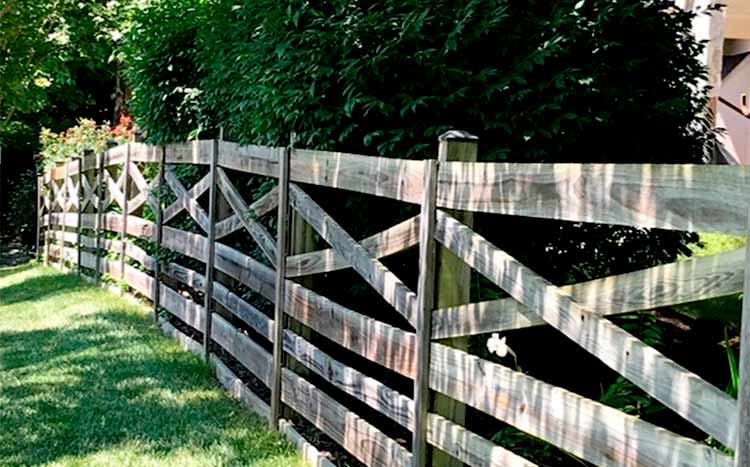Texas is renowned for many features, with the robust safeguarding of property rights by Texans being notably recognized.
With most of them owning large tracts of land and farms, chances of neighborly fence disputes arising are pretty high. That’s why every landowner should know and understand the laws and regulations on fences in Texas.
Here are the key property line fence laws you should know.

What we cover
ToggleDo I need a permit to build a fence in Texas?
In most cities and counties, you won’t need a permit to build a fence shorter than 8 feet of any material. However, in some cities like Dallas, you’ll need a permit to build a fence of over 4 feet in the front yard setback and over 6 feet on the rear or side yard setback.
You will also need a permit if your fence is located on a flood plain area or other special zoning areas. When unsure if your property is in a watershed area, contact the watershed protection department.
How close to the property line can I build a fence?
Every neighborhood has its own rules about property lines and fences, usually set by the Homeowners Association. In most communities, front yard fences should be set back at least 5 feet from the property line.
Other communities may allow you to build the fence up to a few inches to the property line.
If you’re not sure about your local fence restrictions, a good solution is hiring a local fencing company. They’ve probably worked in the area before, and they know the regulations.
How tall can a privacy fence be in Texas?
Most cities have their fence height restrictions set between 6 – 9 feet and demand at least a 50% open structure.
The front yard fences have a restriction of up to 4 feet and about 9 feet for the rear and side fences. This applies to residential properties for single families.
For properties in multi-tenant districts, the restrictions for rear fences stand at 6 feet. If you wish to construct a fence taller than your local authority’s limitations, seek a variance from your local city’s board of adjustment.
Who owns the fence on property lines in TX?
It depends on your agreement. Unlike most states, the Texas fence laws don’t recognize fences on property lines as an obligation for both neighbors. Where there’s no agreement, the fence is the responsibility of the builder.
Your neighbor will only be recognized as a joint owner of the fence if they agree to maintain a part of the fence. Both written and oral agreements can hold in a Texan law court.
If the fence falls on either side of the property line, the Texas Fence laws recognize it as the property of the neighbor on whose property it’s on.
Tip: Before purchasing any property, always confirm whether the fence is jointly owned.

Who gets the good side of the fence?
It depends on the owner of the fence. If you wholly own the fence, then the decision is up to you – the same applies to your neighbor. If you both agreed to co-own the fence, then you’ll have to table that decision with your neighbor.
Nonetheless, having the good side of the fence swap each time is good practice.
You could also opt to install a fence that’s similar on both sides. This solves any dispute for owners who co-share the fence.
Can my neighbor build a fence on the property line?
Yes! Texas doesn’t have an accurate law regarding fencing on the property line. So, your neighbor can build a fence on the property line, but they have to get your authorization first.
Depending on your local municipality or Homeowner’s Association laws, the neighbor might have to send you a 30-day notice of their intent.
Keep in mind, you’ll still be under no obligation to share the costs of the fence if you don’t want it.
Can I put up a fence on my property?
Yes! There’s no law in Texas prohibiting you from putting a fence on your side of the property line. You’ll only need to comply with all the structural, material, design, and height restrictions set by your local community laws.
You also won’t need the consent of your neighbor even if that fence blocks their views and access to light.
But Texas being a ‘fence-out’ state, you have no legal duty to put a fence to protect and manage your livestock.
What if my neighbor won’t pay half?
How you react when your neighbor refuses to pay half of the boundary fencing costs depends on your agreements. If you both agreed, whether orally or on a written contract, to share costs for the fence, here are some steps you can take:
- Send them a written notice requesting them to pay half of the costs
- Consider mediation
- Contact your HOA or municipality to enforce your agreement
- Take legal action in a small claims court to receive a reimbursement
Nonetheless, fence laws in TX are very lenient when it comes to paying for the boundary fence. So, unless you can prove that agreement (on a contract) with the neighbor, there’s very little you can do.
Texas Property encroachment laws
If your neighbor’s new fence extends over the property line into your property, the Texan fence laws allow you to take legal action against them. You have the right to ask the neighbor to remove the fence and also to cover any damages caused.
If you opt to take the neighbor to court, make sure you can prove these two key things: Proof of ownership for the land, and proof that the neighbor uses it illegally.
Adverse possession also works in Texas, where a neighbor can lose part of their property to the encroaching neighbor. Under Texas Civil Practice and Remedies Code § 16.024, the neighbor can claim the portion after 25 years if you’re yet to contest their encroachment.
Texas boundary fence laws at a glance
This table provides an overview of some of the state laws governing Texas fence law and links to their original documents.
| Boundary Caselaw | Spite Fences case law | Encroachment laws |
|---|---|---|
| Nolan v. Mendere, 14 S.W. 167, 168 Griffin v. Sansom, 72 S.W. 864, 864 | Harrison v. Langlinais, 312 S.W. 2d 286 | Texas Agriculture Code, Chapter 143 State laws on fences and range restrictions. |
Keep in mind; These laws are bound to change with time depending on the new legislation, federal court decisions, and other initiatives. Use the information provided above as a guide and research the latest regulations in your municipality.
FAQ’s
Can a neighbor remove a fence?
No! According to the Texas Agricultural code, a neighbor can’t remove your fence or a jointly owned fence without giving you a 6-month written notice first. They’ll first have to consult with you to get your approval for the decision.
If your fence is attached to the neighbor’s fence, they still have to give you a six-month notice before removing their fence.
However, if the fence lies on their side of their property line, they can remove it without your consent.
What if the fence is over the property line?
Fences over the property line are recognized by law as the property of the neighbor on whose side it’s on. This gives that neighbor the sole responsibility of maintaining and repairing the fence.
If your neighbor is building the fence and it has encroached into your land, you have the option to take legal action against them.
In a case where you’re both sharing responsibility for the fence, you should simply renegotiate your building plans then move the fence.
Is Texas a fence in or fence out state?
Texas is a ‘fence out’ or a ‘range open’ state. This means that by law, landowners with livestock are not obligated to construct a fence on their property to keep the animals in.
However, there are some exceptions to this law which are being implemented in different parts of Texas.
This includes the stock law, which states that some animals may be restricted from running at large in the county. The restriction varies in different Texas counties.
The state and federal highway law is another exception that also restricts the ‘fence out’ rule when it comes to highways. It states that any livestock owner shouldn’t knowingly allow their livestock to roam at large on or near the right-of-way of a highway.
Can I build a fence next to my neighbor’s fence?
Yes! With the Texan fence laws covering very few aspects about fencing, you can build a fence wherever you want on your property. You can even consult with the neighbor to see if you can get an agreement to attach fences.
However, be extremely cautious when it comes to property lines. Hire a surveyor if you must to ensure you don’t encroach into their property.













